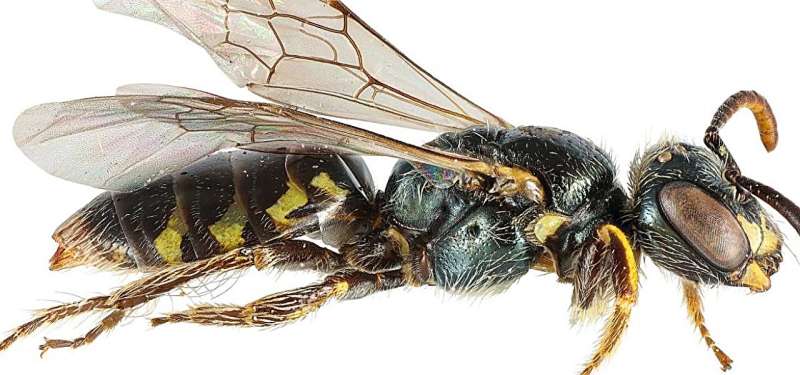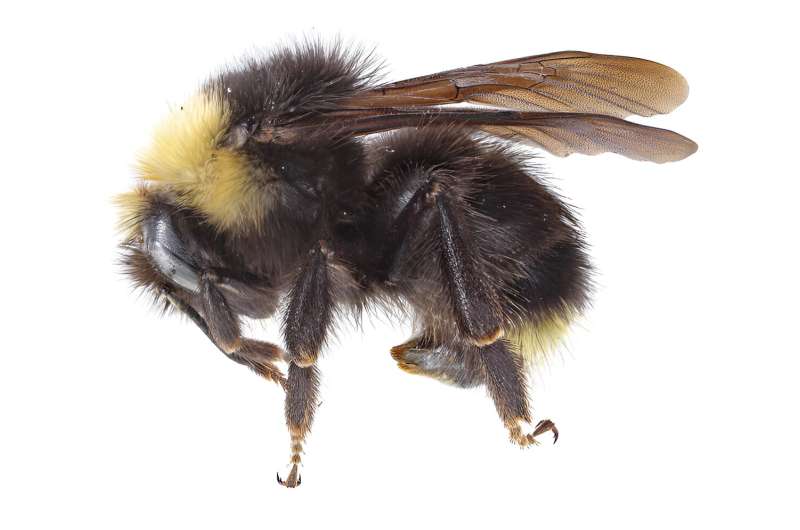This article has been reviewed according to Science X's editorial process and policies. Editors have highlighted the following attributes while ensuring the content's credibility:
fact-checked
trusted source
proofread
New online guides to aid in identification of native bees in Pacific Northwest

Pollinator enthusiasts and scientists have new online tools to identify native bees in the Pacific Northwest.
The publicly available "keys" resemble the field guides familiar to fans of fauna and flora but contain the extraordinary detail needed to identify bees, which are much harder to tell apart than plants, birds, mammals and reptiles, according to Jim Rivers of the Oregon State University College of Forestry.
"With birds for example, one characteristic can tell you whether it's a California scrub-jay or a Steller's jay," said Rivers, who helped develop the keys. "Bees are not that way. Many species appear identical at first but are in fact distinguished by very small, nuanced differences."
Oregon alone is home to more than 600 species of native bees. Bees and other animal pollinators enhance the reproduction of nearly 90% of the Earth's flowering plants, including many food crops, and are an essential component of insect and plant biodiversity.
Bees are the standard bearer among pollinators because they're usually present in the greatest numbers and because they're the only pollinator group that feeds exclusively on nectar and pollen their entire life.
Rivers, Lincoln Best of the OSU College of Agricultural Sciences and the OSU Extension Service, Josh Dunlap of the Oregon Department of Agriculture, August Jackson of Mount Pisgah Arboretum in Eugene and Paul Williams of the Natural History Museum in London put together three separate ID keys: bee genera of the Pacific Northwest, and male and female species keys for the region's bumblebees.

The keys, which took the collaborators about three years to assemble, are aimed at two primary target audiences: Scientists and land managers whose work involves bees, and bee enthusiasts among the general public.
"The small number of people who are really good at identifying bees don't use keys—they just know the species inside and out because they spend so much time working with bee specimens," Rivers said. "We've made our keys easy enough that the amateur can use them, and our expectation is that the keys will benefit all kinds of research projects in this part of the world."
Rivers explained that in the Pacific Northwest, there are perhaps a half-dozen professional bee identification experts whose work is critical for moving forward any research project that depends on knowing for sure which bees are in a particular study area.
"And they're all backlogged for months," Rivers said. "It's a big bottleneck in bee research when you have thousands of specimens you're trying to ID and you have to wait for months before you can get the identification data you need to complete a project. With the keys, we can at least get one step closer to having the identifications we need in a timely manner."
The keys are downloadable and printable but most easily used online, he said. The design uses hyperlinks to navigate users through a decision tree that walks them through what to look for in various parts of the bee anatomy in high-resolution detail.
"You work through a series of dichotomous questions until you can say yes, what I am looking at in my specimen matches what I see on the key," Rivers said. "We got the best high-resolution images we could get for the different diagnostic characters so that the images match what you see in a specimen. That's a big improvement over the idealized hand drawings that most traditional keys have, which can be challenging to use when trying to ID a real-world specimen."
More information: Lincoln R. Best et al, Bees of the Pacific Northwest : key to genera (Hymenoptera : Anthophila) (2023). DOI: 10.5399/osu/1166
Lincoln R. Best et al, Bees of the Pacific Northwest : key to bumble bee species for males (Hymenoptera : Apidae : Bombus) (2023). DOI: 10.5399/osu/1165
Lincoln R. Best et al, Bees of the Pacific Northwest : key to bumble bee species for females (Hymenoptera : Apidae : Bombus) (2023). DOI: 10.5399/osu/1164
Provided by Oregon State University
















